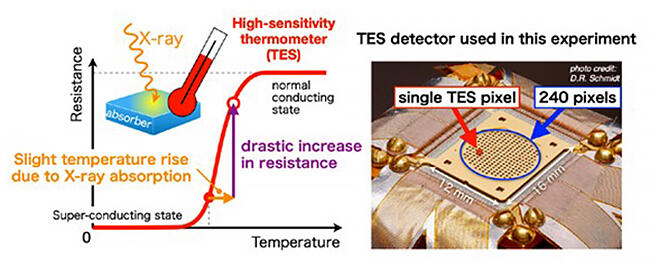An international research group led by Dr. Tadashi Hashimoto, deputy director of the Hadron Nuclear Physics Research Group, Advanced Science Research Center, Japan Atomic Energy Agency (JAEA), and Associate Professor Shinji Okada, Muon Science and Engineering Research Center, College of Engineering, Chubu University, has succeeded in dramatically improving the accuracy of measurements of strong interactions on K mesons using the world's most intense K meson beam provided at J-PARC, a high-intensity proton accelerator facility, and an ultra-high-sensitivity thermometer.

(right) TES detector array used in this work. It consists of 240 small individual detectors.
Provided by JAEA
The group found in X-ray measurements that there is generally a trade-off between detection efficiency and resolution. As such, the Superconducting Transition Edge Microcalorimeter (TES detector), which uses the world's most accurate thermometer, has attracted attention as an X-ray detector that offers both detection efficiency and resolution.
The research group was the first in the world to operate a TES detector in the harsh radiation environment of the high-intensity beam at J-PARC. The detector uses a highly sensitive thermometer based on cryogenic technology, which converts X-ray energy into heat for high-precision measurement but makes it susceptible to external disturbances. However, they established a method to fully demonstrate the performance even in a radiation environment by optimizing the entire experimental setup and data analysis methods. As a result, they succeeded in measuring the energy of X-rays emitted from K meson particles with 10 times the precision of previous measurements. The results provide important fundamental data on the strong interactions acting on K mesons.
The accumulation of high-precision data using similar methods will help demystify strong interactions, including those in high-density regions, which are currently completely unknown, and to shed light on the origin of matter. The established method is expected to bring a great leap forward not only for use in the study of strong interactions, but also for X-ray measurements in various radiation environments, such as accelerator beam experiments including muon atomic X-ray measurements, and space observations by X-ray astronomy satellites.
"Starting with research on strong interactions using the K meson beam, we will continue to develop our quantum beam research and will conduct a variety of quantum beam research in the future, including atomic and molecular dynamics research using muon beams, verification of quantum electrodynamics, geochemistry research using synchrotron radiation and ground-based verification experiments of molecular evolution in the universe using cryogenic ion storage beams," commented Dr. Okada.
This article has been translated by JST with permission from The Science News Ltd.(https://sci-news.co.jp/). Unauthorized reproduction of the article and photographs is prohibited.




